How to Safely Notch a Tree for Direct Felling: A Step-by-Step Guide
- September 27, 2024
- 0 comment
If you’ve ever needed to cut down a tree, you’ve probably asked yourself: How do I safely notch a tree to make it fall where I want? Learning proper tree notching techniques is essential for directing the fall and ensuring safety during the process. A well-cut notch helps control the tree’s direction and reduces risks, making it a critical step in safe tree felling methods. Whether you’re handling a small backyard tree or working in forestry, understanding how to notch a tree for cutting is key to doing the job efficiently and safely. This guide will walk you through the basics of tree felling notches, safety tips, and proven methods to get the best results.
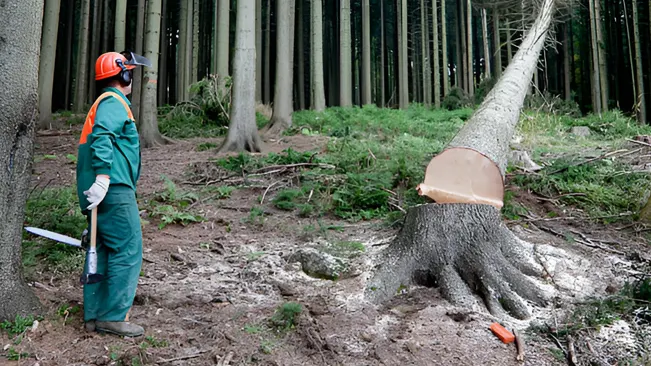
What Does “Notching a Tree” Mean?
Notching a tree means cutting a wedge-shaped opening at the base of the trunk to control the direction of its fall during felling. This notch serves as a hinge, guiding the tree safely and predictably to the ground. To complete the process, a back cut is made on the opposite side, releasing the tree from the stump. Proper tree notching techniques are essential for safety and are a key part of any safe tree felling methods. By understanding how to create tree felling notches, you can ensure better control and minimize risks.
Why Is Notching Important?
Notching is crucial for ensuring that a tree falls in a controlled direction, reducing the risk of injury, property damage, and other hazards. If the notch is poorly executed, the tree could twist, split, or fall in an unintended direction, increasing the danger. By following safe and proven notching techniques, you can reduce risks and increase your control over the felling process.
What to Know Before Notching a Tree
Several factors can impact the success of your notch and, ultimately, how the tree falls. Let’s explore these factors:
- Tree Size and Species
Larger trees require deeper, more precise notches. The density and type of wood can affect how the tree reacts to the cuts. For example, hardwoods like oak or maple may require sharper tools and more effort than softer woods like pine or spruce. - Lean of the Tree
Before making any cuts, assess the tree’s natural lean. A tree with a noticeable lean will naturally fall in the direction of the lean, making it essential to adjust your notch placement accordingly. - Wind Conditions
Wind can influence the tree’s fall. Even a light breeze can change its trajectory. Avoid felling a tree in windy conditions, or factor in the wind direction to ensure it aligns with your desired felling path. - Surrounding Obstacles
Look around the area. Nearby buildings, power lines, or other trees can be in the felling zone. Proper planning will help prevent accidents and ensure the tree falls safely without causing damage.
Types of Notches for Tree Felling
Different types of notches are used depending on the situation and the desired fall direction. The three main types are:
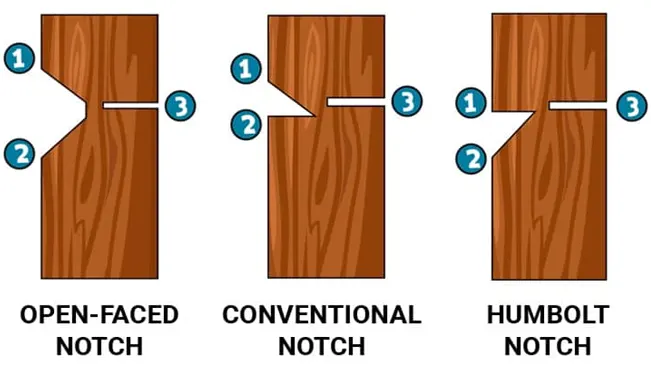
- The Conventional Notch (45°-55° angle)
The conventional notch is one of the most widely used. It consists of a horizontal cut and a downward sloping cut that meet to form a 45°-55° angle. This notch is easy to make and works well for most trees, providing a reliable guide for the fall. However, it can result in a more forceful impact as the tree hits the ground due to a limited hinge length. - The Humboldt Notch (flat-top, upward cut)
The Humboldt notch, also known as a reverse notch, features a horizontal cut and an upward sloping cut. This design is commonly used in mountainous or hilly terrain as it creates less wood waste and makes it easier to cut larger trees. The Humboldt notch also allows the tree to fall closer to the stump, minimizing damage to surrounding vegetation or structures. - The Open-Face Notch (70°-90° angle)
The open-face notch has a larger opening angle, typically between 70° and 90°. This type of notch allows for a longer hinge and more control over the tree’s descent. It’s particularly effective when precision is required, such as when felling near buildings or other sensitive areas. Because the open-face notch keeps the hinge intact for longer, it provides a slower, controlled fall.
Step-by-Step Guide to Safely Notch a Tree
Assess the Situation
Before starting, carefully evaluate the tree, the surrounding area, and weather conditions, including wind direction. Identifying potential hazards, such as nearby structures or power lines, is crucial for safety. Ensure you have a clear escape route planned in case the tree falls unexpectedly. Always wear protective gear, including a helmet, eye protection, gloves, and sturdy boots, to minimize risks. Proper preparation is a cornerstone of safe tree felling methods and ensures the success of your tree cutting techniques.

Make the Face Cut
Begin by making a horizontal cut on the side of the tree facing the desired direction of the fall. This cut should penetrate about one-third of the tree’s diameter. Then, create an angled cut that meets the horizontal cut, forming a proper notch. Precision is critical if the cuts don’t align cleanly, the tree may fall unpredictably, increasing the risk of accidents. Mastering this step is essential for effective tree notching techniques and ensures success when learning how to notch a tree for cutting.
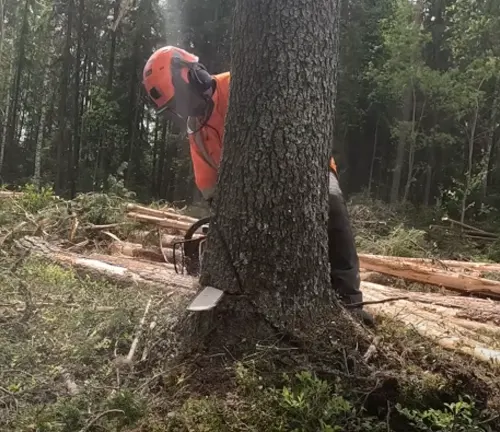
Make the Back Cut
Next, move to the opposite side of the tree, about two inches above the bottom of the face cut, and start the back cut. Keep this cut parallel to the ground for consistency. Stop cutting before the back cut meets the notch; the uncut wood left between the two cuts will form the hinge, which plays a critical role in guiding the tree’s fall. This step is essential for achieving controlled and safe results when applying tree cutting techniques and creating tree felling notches.
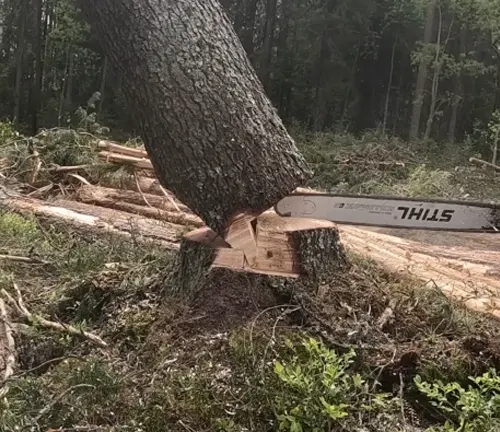
Prepare to Retreat
As soon as the back cut is complete, the tree will begin to fall. Be ready with a planned escape route, and retreat along it immediately once the tree starts to move. Always face the tree as you retreat to stay aware of its direction and movement. Never turn your back until you’ve reached a safe distance. This is a critical step in following safe tree felling methods and ensuring the success of your tree cutting safety tips.
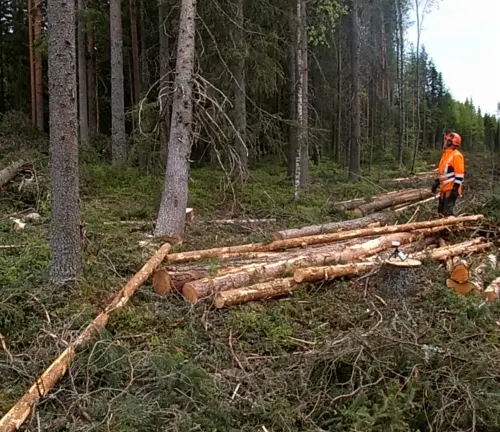
Practical Tips for Safe Tree Felling
- Use Sharp Tools: Dull chainsaws or axes can lead to improper cuts and increase the danger of accidents.
- Work with a Partner: If possible, have someone else with you who can watch for hazards and help guide the process.
- Plan Your Escape Route: Make sure you have a clear path to retreat from as the tree begins to fall, moving at a 45-degree angle away from the direction of the fall.
Common Mistakes to Avoid
- Cutting Too Deep into the Hinge: If the hinge is too thin, the tree can fall prematurely or unpredictably. Always leave a sufficient amount of wood to act as a hinge.
- Ignoring Tree Lean: Cutting a tree against its natural lean can cause the tree to split or fall uncontrollably.
- Underestimating Wind: Even light wind can affect the trajectory of the fall. Always take wind into consideration before starting.
Conclusion
In summary, making the right cuts when felling a tree is a crucial part of safe and controlled tree removal. By understanding the types of cuts, assessing environmental factors, and following proper techniques, you can ensure that the tree falls exactly where you want it to. Always remember to use the right tools, work with safety in mind, and plan your escape route. Tree felling is a serious task, and approaching it with care can prevent accidents and ensure a successful job.
Frequently Asked Questions (FAQ)
- What is the purpose of notching a tree before felling it?
Notching a tree creates a hinge that controls the direction the tree will fall. This helps ensure the tree falls in the intended direction, minimizing hazards to people, property, and the environment. - How deep should the wedge cut be when felling a tree?
The wedge should typically go about one-third of the tree’s diameter. This provides enough of a hinge to guide the tree’s fall while ensuring a clean break when combined with the back cut. - What type of cut should I use for a beginner-friendly felling process?
The conventional notch is often recommended for beginners. It’s easy to create, involves a horizontal and angled cut, and is effective for most tree species and sizes. - How can I determine which direction the tree will fall?
Assess the tree’s natural lean, check for wind conditions, and consider the surrounding environment. The wedge cut should always face the direction you want the tree to fall. - What’s the difference between the back cut and the face cut?
The face cut is the wedge-shaped cut made on the side of the tree in the direction you want it to fall. The back cut is made on the opposite side, above the notch, to release the tree and allow it to fall. - How can I stay safe while felling a tree?
Wear protective gear (helmet, gloves, boots, and eye protection), plan an escape route at a 45-degree angle away from the fall direction, and never turn your back on the tree until you’re at a safe distance. - What should I do if the tree doesn’t fall after making the back cut?
If the tree remains standing after making the back cut, it could be due to an improper hinge or lack of sufficient force. Move to a safe distance and reassess the cuts before attempting any further actions. If unsure, contact a professional.

Charles Hayes
Forestry AuthorI'm Charles Hayes, I bring over 15 years of specialized expertise in landscaping and woodworking, blending artistic design with sustainable environmental stewardship. My career, fueled by a profound passion for the natural world, encompasses extensive education and hands-on experience in creating harmonious, eco-friendly outdoor spaces and responsibly managing forest resources. Recognized for my professional standing, I am committed to continuous learning and certification in cutting-edge practices. My expertise is not only reflected in my work but also in my contributions to community projects, educational workshops, and collaborations with industry leaders. As an authoritative voice in my field, I strive to share knowledge and promote environmentally conscious approaches, making me a trusted resource in landscaping and forestry.













Leave your comment